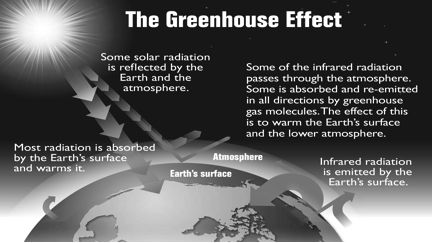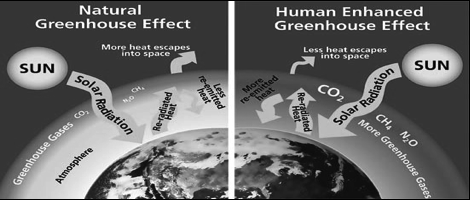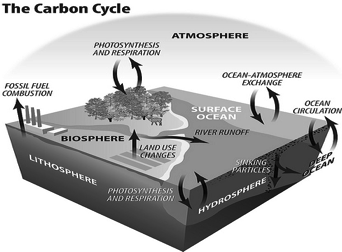The carbon cycle is the exchange of carbon, in the form of carbon dioxide (CO2) or methane (CH4), between the earth’s atmosphere, oceans, land, and all plant and animal life. This exchange of carbon, along with sunlight entering our atmosphere, has regulated the earth’s temperature and climate since earth’s atmosphere emerged over four billion years ago. This interaction between sunlight, the land, the atmosphere and the oceans also produces the Greenhouse Effect.
The Greenhouse Effect
When sunlight (solar radiation), enters our atmosphere about half of it is absorbed by the earth’s surface, warming it. The other half is reflected back by arctic ice, clouds and greenhouse gas molecules in the atmosphere. But another portion of solar radiation is absorbed by those same greenhouse gases in the atmosphere, creating more warmth. Over millions of years a balance of sorts has been established, which provides the earth with the climate we are familiar with. That is why the elements involved create an environment similar to a greenhouse, which is used to provide a constant climate to grow plants. One of the key greenhouse gases is carbon. And that is why the dumping of carbon into the atmosphere is creating such havoc with the environment.
 Carbon Emissions and Global Warming
Carbon Emissions and Global Warming
Scientists say the massive amount of carbon being put into the atmosphere is responsible for much of the extreme climate change we are witnessing today and threatens to disrupt the entire ecology of the planet, with rising sea levels and changing weather patterns.
Carbon plays an important role as a greenhouse gas in the form of carbon dioxide (CO2) and methane (CH4). Like other greenhouse gases, carbon traps energy, in the form of heat, from the sun. The more carbon or other greenhouse gases in our atmosphere, the warmer the planet will become. The result is droughts and desertification, melting glaciers and ice caps, ocean warming and severe storms and temperature fluctuations around the world.
The earth’s history has seen many fluctuations in carbon in the atmosphere, creating much colder and much hotter climates, higher and lower sea levels, than what we have today. But for the past 49 million years our earth has been in a cooling period that created a climate allowing for the evolution of many of the life forms we see today, including humans.
 The concentration of carbon in the atmosphere is measured in “parts per million” or ppm. For all of human existence, the ppm of (CO2) in the atmosphere never exceeded 308 ppm. It was within this environment that our ancestors developed agriculture around 10,000 years ago. But after the birth of capitalism and the Industrial Revolution that followed in the mid 1700s, capitalists started to dig up and burn ancient carbon in large and increasing amounts. This ancient carbon is from animal and plant life that died millions of years ago, decomposed, and can now be found in the form of coal, oil and natural gas buried deep underground. This is why they’re also called “fossil fuels.”
The concentration of carbon in the atmosphere is measured in “parts per million” or ppm. For all of human existence, the ppm of (CO2) in the atmosphere never exceeded 308 ppm. It was within this environment that our ancestors developed agriculture around 10,000 years ago. But after the birth of capitalism and the Industrial Revolution that followed in the mid 1700s, capitalists started to dig up and burn ancient carbon in large and increasing amounts. This ancient carbon is from animal and plant life that died millions of years ago, decomposed, and can now be found in the form of coal, oil and natural gas buried deep underground. This is why they’re also called “fossil fuels.”
So besides all the carbon in our atmosphere, keeping our earth around a steady 300ppm, large companies began burning all this ancient carbon as well, putting millions of tons more of CO2 into the carbon cycle. And for the past 260 years CO2 has been steadily increasing. This heating up of the planet by burning fossil fuels is what is called “Global Warming.” So James Hansen and other climate scientists said that 350 ppm was the limit. After that it is “Game over”. On May 2013, levels at the Mauna Loa observatory in Hawaii hit 400 ppm for the first time in all of human history. This in essence means we are now living on a planet that humans have never lived on before. And the fossil fuel industry keeps pumping out the carbon.


